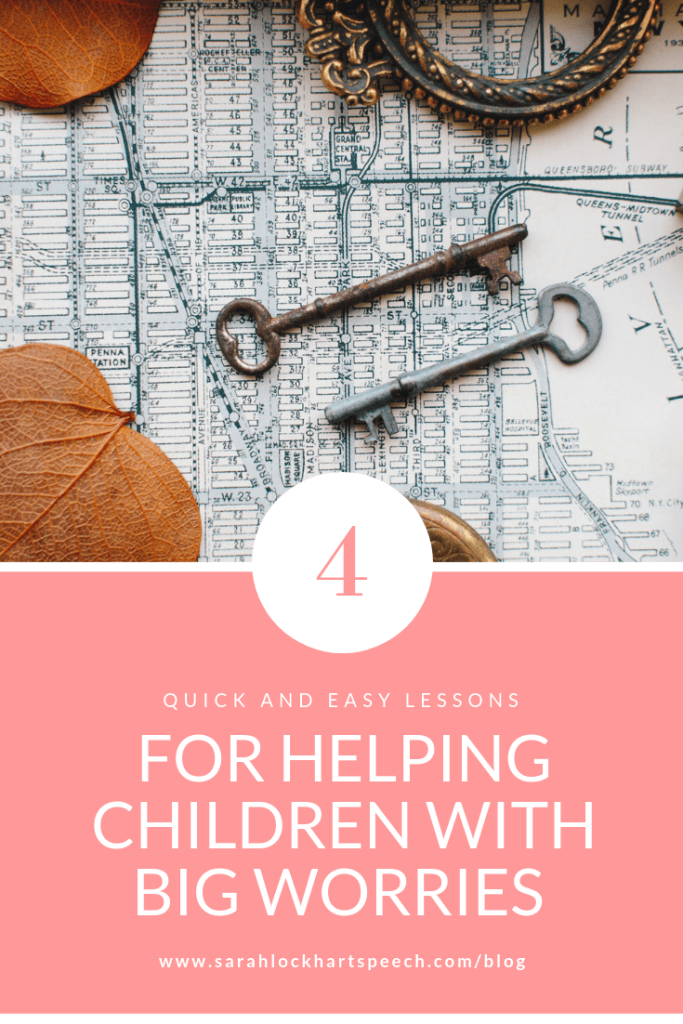Are you a parent or speech-language pathologist helping a child with big worries? This post – aimed at helping children with big worries – is targeted for parents and professionals working with children. Children with a wide variety of diagnoses and needs can have big worries. What can adults do to help? I’ll outline four easy lessons in this post. In posts to come, I’ll dig deeper into this topic.
This is the first part of a four-part series on this topic. My perspectives are highly influenced by a book called Helping Your Anxious Child (Amazon affiliate link). I recommend this book for any adult working with children who have big worries.
But We Don’t “DO” Anxiety
Quickly, I’ve heard the perspective from other professionals that as SLPs, we don’t work on anxiety. My response? As professionals, we know when to refer to outside sources. We should absolutely continue to do that.
However, more than 40% of our students with Autism Spectrum Disorder struggle with autism or depression (Source: Autism Speaks). In addition, 30% of adolescents are struggling with anxiety disorder (Source: National Institutes of Health). Unfortunately, this particular source didn’t track anxiety disorders in younger children, so that resource wasn’t available. Sadly, 60-80% of children an adolescents with anxiety aren’t getting any help for their anxiety (Source: Anxiety and Depression Association of America).
Now, these particular statistics focus on children with a diagnosable disorder. As we know working with children, many children deal with worries that range from mild to persistent, big worries. If we are working with children and adolescents and their worries become something that keeps them from accessing our lessons, we may want to take pause. As professionals, we can decide if a referral to an outside source is warranted. In addition, we may choose to address these worries as a part of our instruction so that we can teach other goals. Examples of goals that may dovetail into discussing big worries would be any goal that touches on self calming, a calming toolbox, identifying the size of the reaction, and a wide variety of social skills goals.
Helping Children With Big Worries
In this post, I’m sharing four lessons you may want to work on with learners who are struggling with big worries. I’m not a psychologist, but I do work with children who might struggle with big emotions. Sometimes emotions like panic, fears, and worries, can get in the way of work we are doing in sessions.
So, this post outlines four tried-and-true lessons to help students start to think about their big worries in healthy ways.
Big Worries: Where To Start?
So, not sure how to help your clients process through their worries? Have you tried a few things, but it feels like there’s no scope and sequence and you are just throwing things together? Or perhaps you’ve tried to teach some lessons on worries but just haven’t gotten the results you wanted?
I’m here to help, so here are your four Lessons for helping your clients work through their worries and develop a toolkit of their own. FYI, this is going to be a multi-part series, and this is just the first one! So if you feel you want more coming down the line, it’s on its way!
What should we teach about worry?
Worry impacts your 1. Feelings 2. Emotions 3. Thoughts
As adults, we need to remember to teach all three of these as we work with learners with worries.
Firstly, teach feelings – and not just a few! Remember anxiety can be worry, fear, panic, and more. List out emotions first by brainstorming then in a lesson. As the adult, you will likely help with this step.
Helpful Term: “Worried Thoughts”
Using the term “worried thoughts” can be very helpful throughout these lessons, particularly at the start. When we have worried thoughts, the thoughts are a worry that we problem solve.
This changes perspectives from “I am a worrier” to “I have some worried thoughts.” This can help the problem solving process. Think of them as thoughts that we are problem solving through. After all, we can change our thoughts.
Lesson One
How do you know when someone is worried? How about when they are scared? Happy? Concerned?
You may want to start with animals (it’s a bit easier) and then move on to other people during your first session. (For example: How do you know when our pet is scared?) Practice thinking about what animals and family members might have “worried thoughts” and if it’s just guess work at this point, that is OK. You are just learning!
To summarize, this first lesson should introduce the term “worried thoughts.” From there, you may move to discussing how animals, family members, or people in magazines might feel when they have a variety of feelings. How do you know when they are worried? Happy? Scared?
Lesson Two
Create an outline of your body or draw an outline on a piece of paper – show your learner where the “worried thoughts” and feelings can make your body feel different. Start by explaining what it’s like for you – after all everyone has worried thoughts. If you are working with an older/adolescent learner, creating a visual can still be very helpful, but come up with an idea on how to do this together that feels age appropriate.
Lesson Three
Look at magazine pictures of people with a variety of emotions. First, identify what emotion these people are feeling. Next, guess what people are thinking based on their nonverbals. You can also ask questions like: What’s a thought that might make them happy? What kind of thought might make them feel worried or sad?
Remember, different people have different thoughts, and the same event can make different people feel differently. This lesson might get silly, but let it go there. It’s OK if some of the answers are fun, silly events. You are still practicing and brainstorming, and when activities are fun, kids are more likely to learn.
Lesson Four
If you aren’t familiar with a five point scale, a quick internet search will give you plenty of examples.
Here, we make a 5 point worry scale. Make sure to have columns for body, brain, behavior and thoughts.
Vertical columns should be: a scale of 1-5, space for the learner to draw their face with this emotion, and columns for each of the following: body, behavior, and thoughts.
For example, panic might be a 5 (the biggest emotion) for a particular child. He or she may share the following to add to the scale:
Body – feel shaky, stomach ache
Behavior – may avoid situations, freeze in situations
Thoughts – I can’t do this, racing thoughts, I need to run away
Creating this scale will likely take a few sessions, and younger learners will need more help than adolescents.
Helping Children With Big Worries – Frequently Asked Questions
How long do these lessons take?
Pay attention to the attention span of your learner, it will depend on the child’s age and attention.
Should each lesson just take one session?
Nope. You can do these lessons a few times and dig deeper into the topics as you go.
Would these lessons work for older children and adolescents?
With some modifications, yes. Keep in mind the age of your learner as you try these activities.
Overall, remember to keep these lessons fun and engaging. We never want to make our learners feel judged or different. The thing is, we all have big worries (even you and me). Teaching children these emotional literacy pieces is very important, but should be done in an engaging and approachable way.
Further Reading
Do you enjoy reading actionable lessons like this? If so, you may want to scroll back to posts on writing social skills goals, or 15 easy conversational prompts for speech sessions.
Sarah Lockhart is a private practice speech language pathologist in the Rogue Valley, Oregon. She works with learners with a variety of disorders but especially: late talkers and children with significant speech sound disorders (like Childhood Apraxia of speech).


